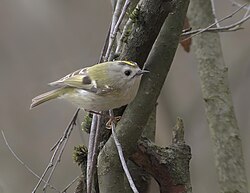菊戴
Appearance
Japanese
[edit]| Kanji in this term | |
|---|---|
| 菊 | 戴 |
| きく Grade: S |
いただ(き) Grade: S |
| kun'yomi | |
| Alternative spelling |
|---|
| 鶎 (rare) |

Etymology
[edit]Compound of 菊 (kiku, “chrysanthemum”) + 戴き (itadaki, “top → crown”), from the bird’s crest plumed like the flower.
Pronunciation
[edit]Noun
[edit]菊戴 or 菊戴 • (kikuitadaki)
- a goldcrest (Regulus regulus)
- Synonym: 松毟鳥 (matsumushiri)
Usage notes
[edit]As with many terms that name organisms, this term is often spelled in katakana, especially in biological contexts (where katakana is customary), as キクイタダキ.

